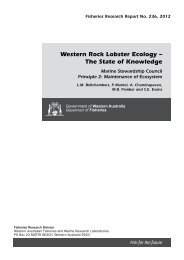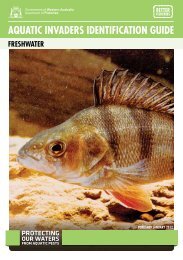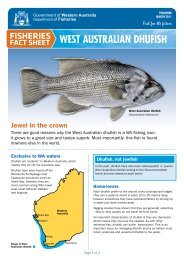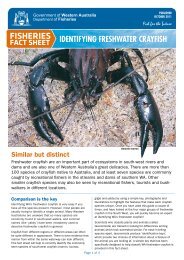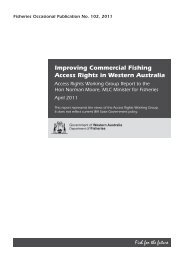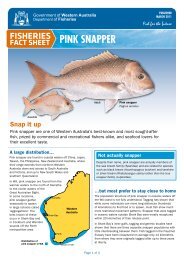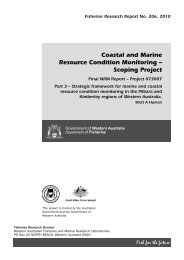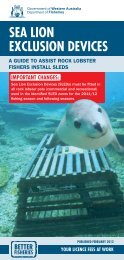Assessment of gonad staging systems and other ... - CiteSeerX
Assessment of gonad staging systems and other ... - CiteSeerX
Assessment of gonad staging systems and other ... - CiteSeerX
Create successful ePaper yourself
Turn your PDF publications into a flip-book with our unique Google optimized e-Paper software.
eventually forming a narrow row (the cortical alveoli) near the periphery <strong>of</strong> the cytoplasm.Clear staining oil droplets also appear within the inner region <strong>of</strong> the cytoplasm, increasing insize <strong>and</strong> number around the central nucleus. The cortical alveoli stage marks thecommencement <strong>of</strong> <strong>gonad</strong>otropin-dependent oocyte growth when vitellogenesis occurs(Wallace <strong>and</strong> Sellman 1981), <strong>and</strong> was therefore used to identify the developing ovarian (F3)stage.2.Vitellogenic GrowthYolk Globule Stage 215-640µm in diameter (mean ≈ 450µm). Development into this stage ismarked by the appearance <strong>of</strong> small pinkish-red (acidophilic) yolk globules in outer regions<strong>of</strong> the cytoplasm. These can only be distinguished under high magnification to begin withbut increase in size <strong>and</strong> number to fill the cytoplasm as the oocyte increases in size. Thezona radiata is well developed <strong>and</strong> striated.Ripe Stage: 500-800µm diameter (mean ≈ 690µm) during migratory nucleus stage; 560-1,140µm diameter (mean ≈ 870µm) when hydrated. Maturation into this stage is marked bythe migration <strong>of</strong> the nucleus to the periphery <strong>of</strong> the oocyte <strong>and</strong> coalescence <strong>of</strong> the oildroplets. The nucleus breaks down when it reaches the periphery, the yolk globules coalesce<strong>and</strong> hydration occurs as the oocyte takes on a uniform pale pink appearance <strong>and</strong> rapidlyexp<strong>and</strong>s in size. The zona radiata becomes reduced in thickness.Classification <strong>of</strong> <strong>gonad</strong>s into developmental stages was based on the <strong>staging</strong> system used byMcPherson (1992) for tuna, with modifications made to the names <strong>and</strong> order <strong>of</strong> the stages.This system was used to microscopically stage preserved <strong>gonad</strong>s that had been sectionedtransversely at 5 µm using st<strong>and</strong>ard histological techniques. The same system was also usedto macroscopically stage fresh <strong>and</strong> frozen <strong>gonad</strong>s prior to review <strong>of</strong> its accuracy for thispurpose <strong>and</strong> subsequent simplification.2.2.5 Staging <strong>of</strong> post-ovulatory folliclesPrior to ovulation, each oocyte is encased in a follicle comprised <strong>of</strong> an inner epithelial layer<strong>of</strong> granulosa cells <strong>and</strong> an outer connective tissue layer <strong>of</strong> thecal cells (Hunter <strong>and</strong> Macewicz1985). At ovulation, the oocyte is released into the lumen whilst the ruptured follicle (postovulatoryfollicle) remains within the lamellae. Post-ovulatory follicles (POFs) are shortlivedbut readily distinguishable, particularly because they are usually quite common whenpresent. In fish inhabiting tropical waters, they may remain up to 24 hrs in the ovaries beforebeing reabsorbed (West 1990, Samoilys <strong>and</strong> Roel<strong>of</strong>s 2000), with evidence to suggest this isthe case with S. commerson in Queensl<strong>and</strong> waters (McPherson 1993). Post ovulatoryfollicles present in the ovaries <strong>of</strong> Spanish mackerel were categorised as either ‘new’ or ‘old’based on their appearance (Table 2), in order to distinguish between groups <strong>of</strong> POFs <strong>and</strong>provide more detail <strong>of</strong> spawning history.8 Fish. Res. Rep. West. Aust.2001, 136, 1-32



